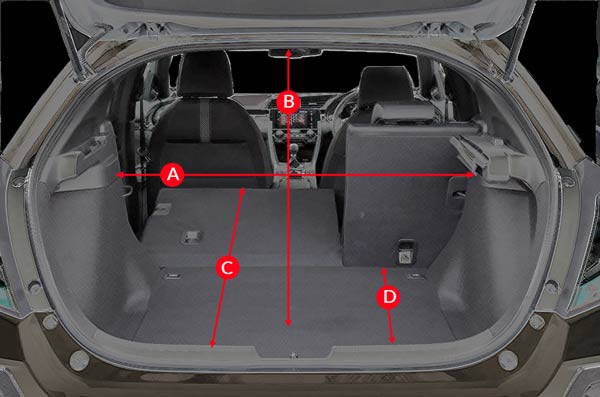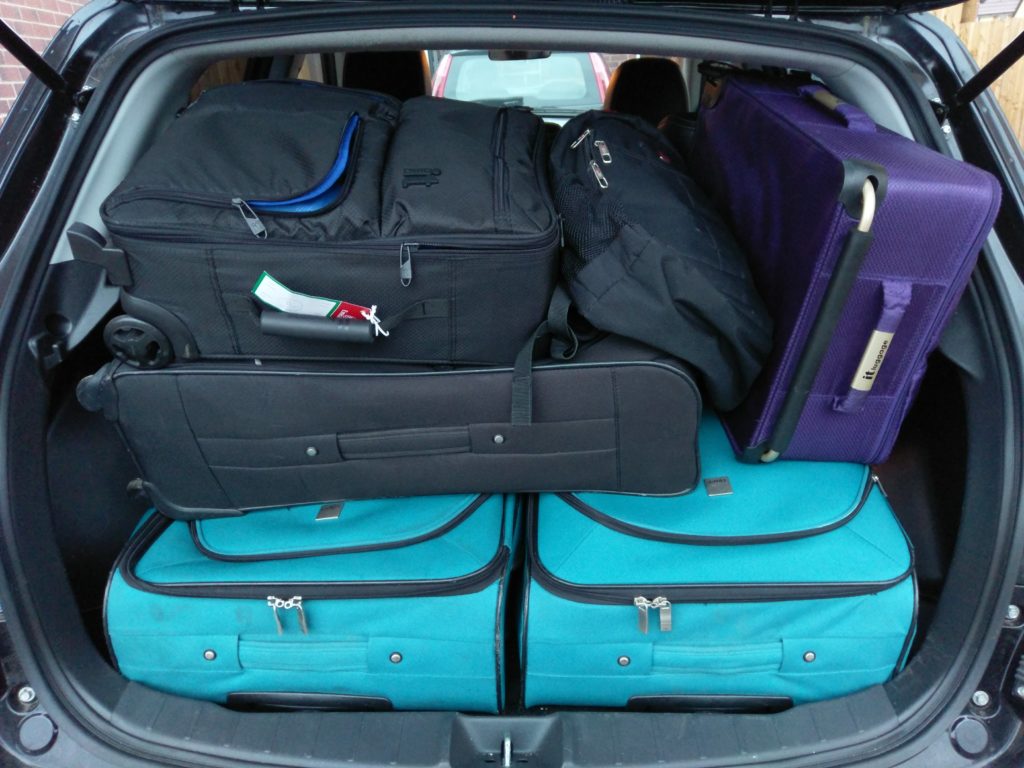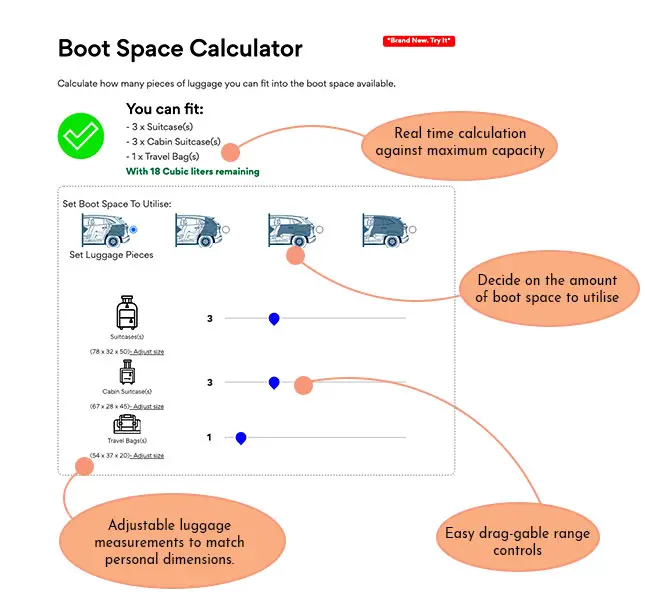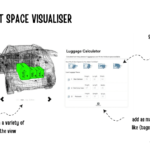What is boot space and how is it calculated?

Confused by How Car Companies Calculate Boot Space?
We show you how to calculate the car boots space in a Way That Has Meaning for You.
- Content Outline
- Introduction
- The most common way car boot space is calculated
- So, what are the standards when calculating car boot space?
- Option 1 – Calculate the boot space with car boot dimensions
- Option 2 – Load your stuff in the trunk to estimate boot space
- Option 3 – Use our free cargo space calculator
- References & FAQs
When shopping for a car, one of the most important factors to consider is how much boot space it has. This is especially important if you have a large family or travel with a lot of luggage.
Car companies continually advertise the amount of boot space their cars have in litres, but how do they come up with that number? Why is boot space measured in litres?
Does this number actually take into account how much space is actually usable?
In this blog post, we will explain how car companies calculate boot space and give tips on how you can do it yourself in a more meaningful way.
Before we start, let’s start by aligning our understanding.
What is Boot Space in a car?
Boot space in a car refers to the storage capacity available in the rear compartment (and sometimes front in popular makes such as the Tesla Models an Porcsche that have both rear and front boots), commonly known as the trunk, boot or Frunk(as referred to by tesla).
It is the designated loading area where you can store your luggage, groceries, sports equipment, or any other items you need to transport. The boot space is designed to provide a secure and enclosed storage area separate from the passenger cabin.
The size of the boot space can vary significantly among different car models and manufacturers. It is measured in liters or cubic feet and represents the total volume of the storage area. A larger boot size allows you to carry more items, while a smaller space may require careful packing and prioritisation.
For example, a compact hatchback might have a top boot capacity of around 300 liters, which is suitable for everyday shopping or carrying a few small suitcases. On the other hand, a large SUV or estate car could offer a boot space of over 1,000 liters, providing ample room for luggage, camping gear, or larger items.
Quick Tip: When considering the boot space, it is important to take into account whether the rear seats can be folded down to create additional storage capacity. This flexibility allows you to accommodate larger or longer items by utilising the extended floor space.
The Most Common Way Car Boot Space Is Calculated
Car companies use various methods to calculate their vehicles’ boot space.
The first thought that comes to mind is that one would simply measure the space’s length, width, and height and multiply those numbers together to get the total volume of the boot in cubic feet.
Sadly, it’s not as simple as this.
The attempt to standardise the way car boot space is measured across all manufacturers proved futile.
If you dig a little deeper, you will find that some manufacturers will measure the space up to the top of the parcel shelve and others all the way to the front seats and roof of the car.
Some offer boot space figures ranging from, e.g. 540 litres to 1250. This means they are giving you a range between the boot space with the rear seats up and the amount of boot space with the rear seats folded, adding even more confusion to consumers and making it even harder to compare the boot space between different vehicles.
Sadly none of this helps you; the consumer knows exactly how much stuff the boot space can take.
So, what are the standards when calculating car boot space?
VDA, SAE, and maximum load volume are the three most common methods of measuring the volume of a boot.
So, when looking at car boots between two different manufacturers, ensure you know which method of measurement has been used so that you can adequately compare them. That way, you’ll be sure to choose the car with the right amount of space for your needs.
- VDA (Verband der Automobilindustrie) is the most common method of measuring car boot space. It stands for ‘Vehicle Design Area’, and it takes into account the boot’s shape and volume.
- SAE, (Safe Approach and Entry), is a newer method that tries to give a more realistic representation of the amount of space that is actually usable. It includes things like the space taken up by the spare tyre and the height of the boot opening.
- Maximum Load Volume is simply the largest amount of space that can be used, regardless of shape or other factors.
There is nothing more frustrating than packing very lightly, only to find out at your destination that you could have carried more, or having to upgrade the car on arrival simply because you packed too much stuff for the car you rented.
Let’s discuss how you can try to ensure none of the above happens to you.
Method 1 – Calculate the boot space with car boot dimensions

The best way to calculate the space is to get the measurement of the boot space.
To measure a car’s boot space, you will need to first find the dimensions of the space. To do this, you will need to take measurements of the boot’s length, width, and height.
(Caption) Here are the minimum measurements you want to take to determine the total space available.
- A = Minimum Width Across
- B = Maximum Height
- C = Length With Seats Down
- D = Length With Seats Up
Once you have these measurements, you can calculate the volume of the boot by multiplying the length by the width by the height.
How to get the measurements if you don’t have access to the car
However, it is unlikely that you will have access to the actual car you want to calculate boot space for. In that case, you can plan to visit the dealership or hire shop before your purchase or travel. If you can’t get out to see the car and measure the boot yourself and you want to be 100% sure about the boot space of a particular vehicle, your best bet is to call the company that rents or sells the car and ask them to give you the measurements over the phone.
The representative should be able to tell you the specific measurements of the boot space so you can determine if it will be sufficient for your needs.
If you’re still not convinced, you can ask if they have any pictures or videos of the trunk so you can get a better idea of the size.
Asking questions and researching ahead of time will help you make the best decision possible and avoid any surprises when you’re trying to pack for your trip.
p.s Keep in mind that the amount of boot space can vary depending on how the car luggage space is configured. For example, some vehicles have a split-folding rear seat that can give you more space when needed. If you are looking for a vehicle with a lot of boot space, be sure to ask how the seats can be configured to give you the most space possible.
Option 2 – Load your stuff in the trunk to estimate boot space
Assuming you don’t have access to the physical car you want to hire or purchase and you don’t want to engage in any sales calls when calling to simply ask about the boot dimensions as described in our earlier point, then you can use one of the other methods car companies use.
They fill the trunk with actual luggage and measure how much it can hold. This is closer to the (SAE Standard way of measuring boot space).
We prefer this method as it gives a more accurate number of space you will have when using the trunk.
“But, what if I don’t have access to the car to measure the boot space” I hear you ask?
Listen closely for a clever hack.
First, you need to gain access to the car.
Here are a couple of ways to gain access to multiple cars so that you can compare boot spaces.

- Ask A Friend – Ask a friend who has the same type of car to pay you a visit so that you can calculate how much space can fit in the boot.
- Hire The Car – Hire the car for the day or book a test drive of the vehicle you want to purchase or hire. Whilst this will cost you money for the day hire, it will save you time, stress and money later.
- Visit Care Hire Location – Call the car hire company and ask them if you can visit their site with your empty suitcases to work out exactly which car and model will fit your luggage. Make sure you arrange this on a day when they have multiple models available for you to access.
Once you have access, fill the trunk with as much luggage as you think you would need for a trip and then measure the length, width, and height of the filled trunk. This will give you a reasonable estimate of how much space you would have to work with.
p.s Remember to fill side cupboards and false floors with shows, books or any other small items you are taking on your trip. That way, you maximise the content you are carrying.
Option 3 – Use our cargo space calculator

We believe that knowing how much boot space is available is essential when purchasing or leasing a car.
That’s why we designed and developed a boot space calculator to help you determine how much space you need to carry your luggage for that next trip or for that long-term family purchase you’ve been thinking about.
You can also use our boot space calculator to estimate the amount of cargo space available in different makes and models of cars.
References & FAQs
About the The Verband der Automobilindustrie (VDA)
The Verband der Automobilindustrie, or VDA, is a German car industry association that uses a car boot calculation to determine the size of a car’s load space. Filling the boot in this manner involves putting ‘litre’ blocks, each measuring 200x100x50mm. This is followed by counting the blocks and converting the results into cubic metres.
About The Society of Automotive Engineers (SAE)
The Society of Automotive Engineers developed a standardised luggage set consisting of seven different-sized items. This method can be used to measure the capacity of any car’s luggage compartment, allowing consumers to compare the space available in different models. The SAE luggage set includes:
- A small overnight bag.
- A medium-sized suitcase.
- A large suitcase.
- A golf bag.
- A garment bag.
- A set of golf clubs.
- A set of skis.
To use this method, passengers can simply place the items into the car’s luggage compartment and see how much space is left over. A good number of American car manufacturers use this measuring method.
https://www.sae.org/publications/technical-papers/content/2011-01-0781/
Frequently Asked Questions
Q: What is the difference between a boot and a trunk?
Answer: The British word “boot” has many definitions, but in the United States, it’s commonly used to refer not only to footwear for your feet- but it can also mean luggage or groceries!
The American usage of this term makes more sense because our cars usually have trunks where you’ll find all these things anyway, so there isn’t really any need at first glance for them to be called ‘boots’.
Q: Does the measured boot space include the rear seats area?
Answer: No, the rear seats area is typically not included when calculating the boot space of a car. Boot space refers specifically to the storage area in the rear compartment of the vehicle, separate from the passenger cabin.
When measuring the rear seats are usually in their upright position unless otherwise specified. The available space is measured from the floor of the boot to the height of the opening, and from side to side for the width. The depth or length of the boot space is measured from the rear of the boot to the back of the rear seats.
However, it’s important to note that some cars have a feature called “rear seats fold-down” or “split-folding seats.” In such cases, the luggage space can be expanded by folding down the rear seats to create a larger and more versatile storage area. With the rear seats folded, the overall storage capacity increases, allowing you to carry longer or bulkier items. The flexibility provided by fold-down seats is beneficial when you need larger luggage capacity while still having the option to accommodate passengers in the rear seats when needed.
Q: Why is boot space measured in litres?
Answer: Litres are commonly used to measure the volume of liquids, so it may seem strange that they are also used to measure the boot space in a car. However, there is a reason for this. The standard size for a boot space is 500 litres, which is the equivalent of two standard suitcases. This measurement is useful for customers when they are trying to compare the size of different car models. In addition, litres are easy to convert into other common measurements, such as gallons or cubic feet. As a result, using litres to measure boot space makes it easier for consumers to understand the available storage space in a vehicle.
Q: Is there a tool or calculator available to determine the boot space of different car models?
Yes, there is a tool or calculator available to determine the boot space of different car models. It even allows you to compare them side by side. You can access our Boot Space Comparison tool here
Q: Can I rely on car rental or dealership representatives to provide accurate boot space measurements?
Answer: In general yes you can rely on car rental and dealership reps as long as they provide you with official care dimensions and measurements of the luggage space of the car you are interested in. Once you have the that data you can use it to calculate the boot space in liters
Main Photo by Richard Jaimes on Unsplash








